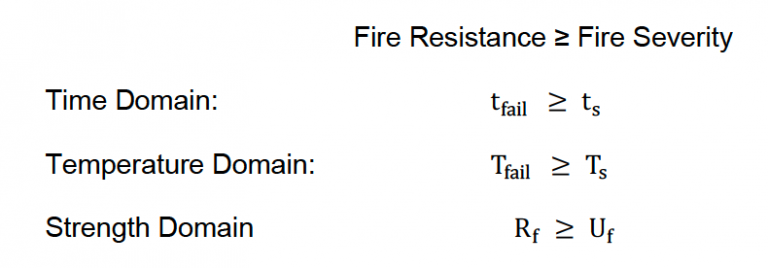An accidental fire in a building can result in the failure of its structural members or elements as upon heating, the load-bearing capacity of structural members reduces with the increasing temperature (Jose L. Torero, 2004). Structural fire engineering ensures that the structural members, irrespective of whether they are steel, timber, or concrete, are able to maintain their structural integrity during a fire condition. The structural integrity is considered to be met when the load bearing elements of the structure of the building are capable of withstanding the effects of fire for an appropriate period without the loss of stability. The loss of load-bearing capacity is the sole failure mode addressed by structural fire engineering while the other performance criteria are assessed by the fire resistance framework. Structural fire engineering generally follows the same approach as the structural design under ambient conditions. However, as a severe fire in most buildings is a statistically rare event, the load (α), and resistance factors (Ø) in fire limit state design change to reflect this fact (David Lange, 2019). The main differences in the structural analysis under fire condition to the typical structural analysis in ambient conditions are (David Lange, 2019):
- There may be a reduction in material strength
- There may be a reduction in cross-sectional areas, i.e, timber
- The onset of different failure mechanisms
- The thermal expansion and thermal bowing resulting in geometric changes
The fire resistance and fire severity are addressed using three domains – time, temperature, and strength. The structural elements should be designed in a way that the inherent fire resistance is greater than the fire severity:

At Sotera, the engineers hold a deep understanding of heat transfer, fire dynamics, and structural engineering which can help deliver optimal and rational fire resistance designs. The team possesses expertise in fire
safety/structural engineering which is crucial for the application of current provisions in codes and standards to practical situations. The team is capable of carrying out time equivalency calculations to rationalise the FRL’s of structural elements, optimisation of structural element size using finite element analysis, and thermal calculations of structures in fire using heat transfer/balance.
In addition, the fire engineering team at Sotera can help provide the following benefits:
- Improvement in structural efficiencies
- Simplification of the structural design
- Reduction in building cost.
- Improvement of an existing structure
- Rationalisation of separation between different classifications in a building
- Advice on passive fireproofing of unprotected structures – Intumescent coatings, spray-on systems, board systems
- Advice on employability of engineered wood products, i.e, cross-laminated timber, glulam, as core structural materials to conventional materials, i.e, steel or concrete
For more information Contact our friendly team today.
Bibliography
A.F. Robertson, D. G., 2018. Fire Load, Fire Severity, and Fire Endurance, s.l.: University of Queensland.
David Lange, 2019. Structural Mechanics under high temperature. s.l.:University of Queensland.
Jose L. Torero, B. L., 2004. The changing face of structural design for fire. International Fire Buyers Guide.
Ventatesh K.R Kodur, M. N., 2020. Structural Fire Engineering. Research Gate.

